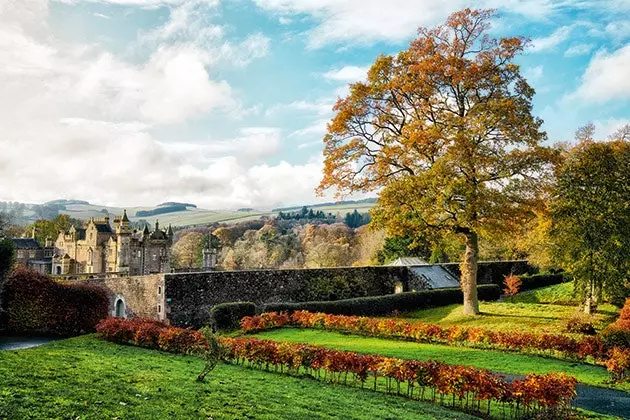
Thousands of travelers arrive to the mythical Abbotsford with the aim of approaching the places where Scott perges some of his works.
“No, there is no elevator” , replies the official with a mocking half smile when he asked him a question that seemed to have answered a million times. “It's only 287 steps and, besides, going up the Scott Monument is good for the body and soul: it improves cardiovascular health and allows you to get to know our city in a unique way ”, He argues from his tiny booth lined with Edinburgh postcards and miniatures of the monument with which the Scots honored their most universal novelist: ** Sir Walter Scott (1771-1832) **.
The 360º panoramic view offered by the 61-meter-high Gothic spire is sublime. The passers-by on Princes Street, way to work or waverley train station –Title of Scott's first novel with which he inaugurated the romantic movement in this genre–, they look like hyperactive ants . No vantage point like this to seal the goal of my trip: to discover the Scotland that inspired Scott and that, with his poems and novels, projected the world with a magnetic, fertile and noble stamp. And yet, that tour of the kingdom of the 'genius of the north' would not have Edinburgh as the main stage . Born in the Old Town, his traces are constant in the capital, but this was not the great stage of his literary architecture. That place of inspiration and creativity materializes in two other regions: the borders , where he lived much of his life, and Loch Lomond & The Trossachs , the strip of land north of Glasgow that he made into a landscape of legend with two of his masterpieces.
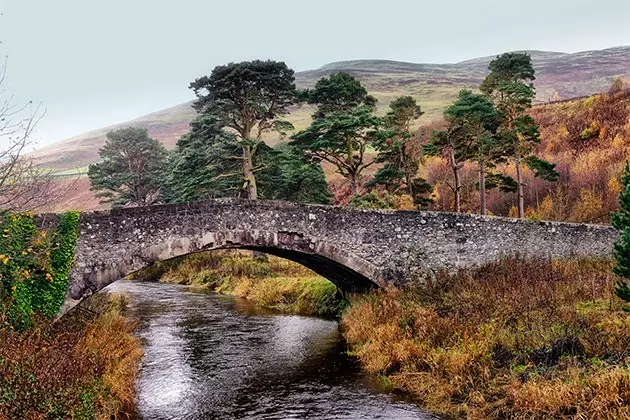
The historic buildings and bridges of Peebles, in the Scottish Borders, captivate
from Edinburgh, the A7 crosses in one hour the 60 km that separate the capital from the heart of the Borders . That was the path that Scott followed for years when he served as sheriff in the county of Selkirkshire, a position that he would hold until the last years of his life. I read it in an old copy of Scott's biography written in 1954 by Hesketh Pearson and It will accompany me like a compass during the trip . After passing a sign saying goodbye to Midlothian council, another one welcomes the Borders. Just then the sun disappeared behind a thick fog. It is one of those spells that the Scottish weather wears out. But something else. Behind that curtain another Scotland opened up. “The people of the Borders are neither English nor Scottish, they are Borders ”, Ian had warned me, the taxi driver who picked me up at the airport. He was right. Located in the southeast of the country, the borderlands between Scotland and England were during the Middle Ages and until the 18th century the scene of bloody battles and looting . The convulsive anvil where the kingdom of Scotland was forged.
It took Ian no more than ten minutes to present a Scottish political science master class with the results of the historic referendum of September 18, 2014 still latent. "Did you know that, of the 32 constituencies in the country, Scottish Borders was the second with the most votes, 66%, against secession?" “ And what would Walter Scott have voted for? ", I ask. He replies without batting an eyelid: “The baronet – he explains, referring to the writer with the noble title he received from King George IV – surely he would have voted no to independence. Quite the opposite of Robert Burns. Now that he was a poet and a Scottish patriot! ”.
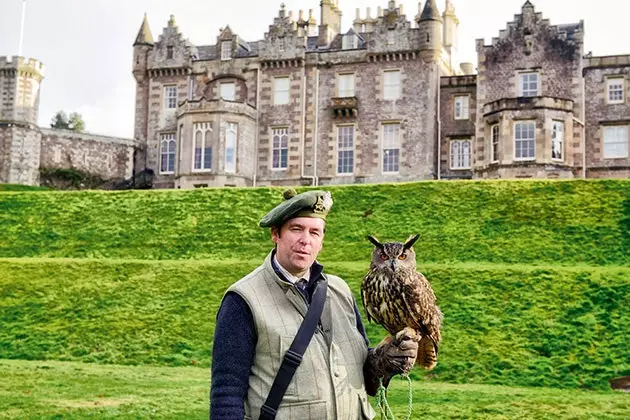
Falconer Stewart Miller, next to the owl Whizzer, outside Abbotsford, where travelers enjoy a falconry show
The town of Melrose appears before my eyes. The mist has cleared, so I head towards mythical Abbotsford, the home of Scott and his family since 1812. Or “ the delilah of my imagination ”, as he called it. "I wanted to settle down where she could spit into the River Tweed, without which I don't think she could have been happy anywhere," he confessed to a friend.
Abbotsford exudes the perfume of literature. As I wander through the library I am enthralled by the wooden coffered ceiling , imitation of the style of the Rosslyn Chapel. In the next room panoplies, trophies and relics create a kind of horror vacui. In the drawing room, a portrait of Scott next to one of his dogs, Camp, captures my attention. “That bull terrier accompanied him for years on his excursions through the Borders. He loved him as one of his children ”, explains Peppa, my guide in the house. By the baronet's desk, fierce eyes framed by a shock of red hair glare at me from a portrait on the wall. It is Rob Roy MacGregor (1671-1734), the bandit that Scott turned into a literary myth with his homonymous novel and whose wanderings in The Trossachs inspired part of my journey.
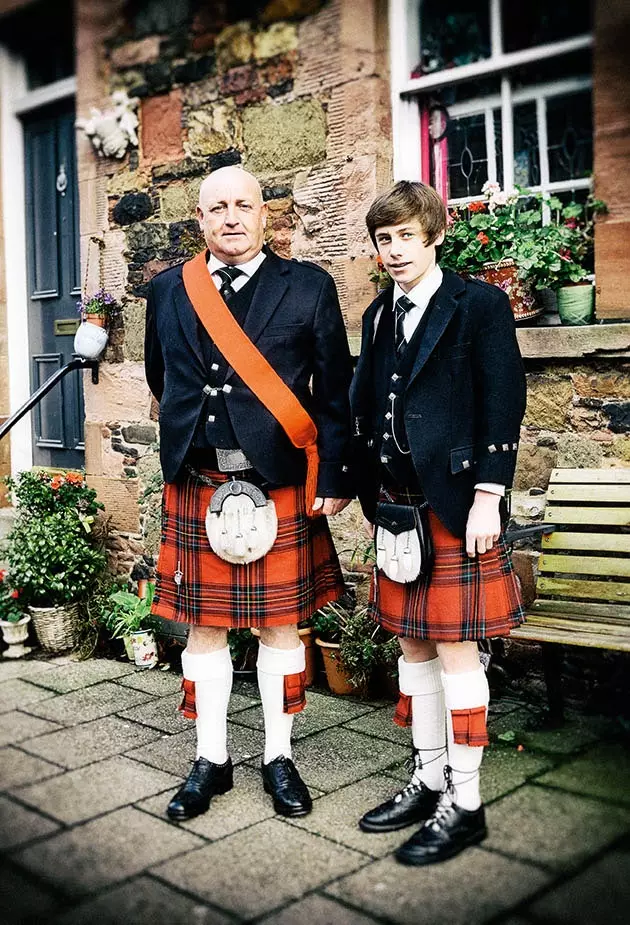
In Melrosa, with the typical Scottish kilt, a skirt worn by men now only on special occasions
"Such was Scott's passion for Abbotsford that, after his collapse as a publisher in 1826, he wrote until he was exhausted so as not to part with her ”, explains Peppa. The novelist died on September 21, 1832. “Before expiring he ordered that they take him near the window of the dining room to be able to listen to his beloved Tweed ”, He remembers.
Back in Melrose, I gaze at the vermilion stones of the Cistercian abbey made famous by Scott's lines in Song of the Last Minstrel (1805) . And I do it with the groan of the bagpipes that summon the more than 2,000 inhabitants of the town. “We celebrate Remembrance Day, in memory of the death of our soldiers in the First World War ”, explains Gerry Graham, the leader of the band of pipers with the silver mallet resting on his shoulder. This popular demonstration is a gift of chance to press the ancestral codes of the Borders. Because in Market Square, all the living forces of the town They meet to insert themselves in a silent row . It looks like a Scottish film by Berlanga: the priest, the mayor, the school teachers, the war veterans... even the boy scouts create a hierarchical entourage that silently leads the way to the church to the beat of Scotland the Brave. Modern metaphor for the status quo of a Scottish clan.
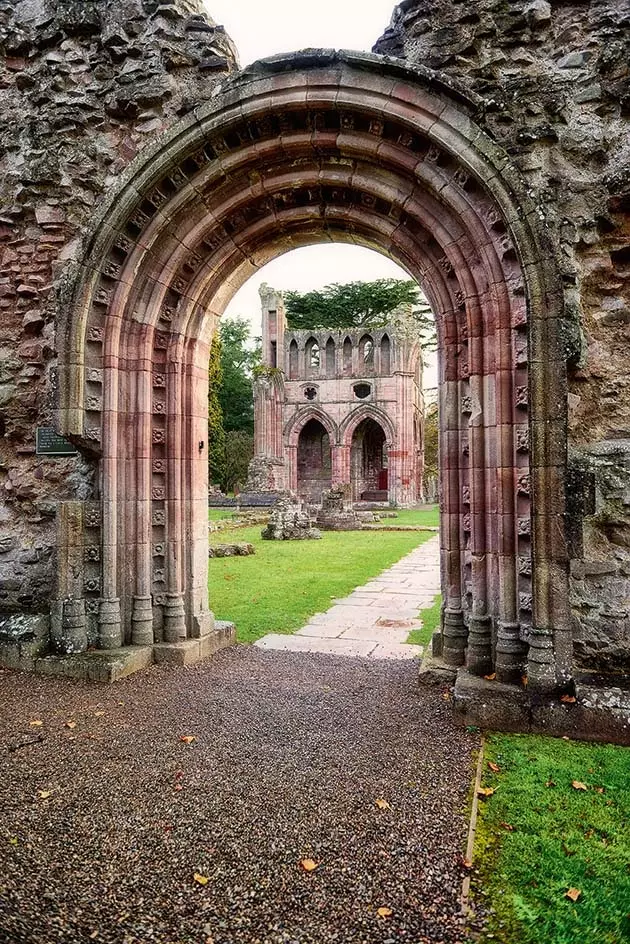
Dryburgh Abbey, on the banks of the River Tweed
That image accompanies me to the ruins of Dryburgh Abbey. Founded in 1150 on the banks of the Tweed, within its time-worn walls is the tomb of Sir Walter Scott. Not far away, a steep little road takes me to Scott's View , the novelist's favorite sight. An emotional panoramic view of the meanders of the Tweed and where the hills of Eildon spread out below us . Chronicles tell that, next to the viewpoint that invites you to contemplate how the landscape of the Borders changes, the horses that pulled the hearse with its coffin stopped . They had made the journey from Abbotsford to Dryburgh dozens of times with their master, so no one had to order them. That was his last tribute.
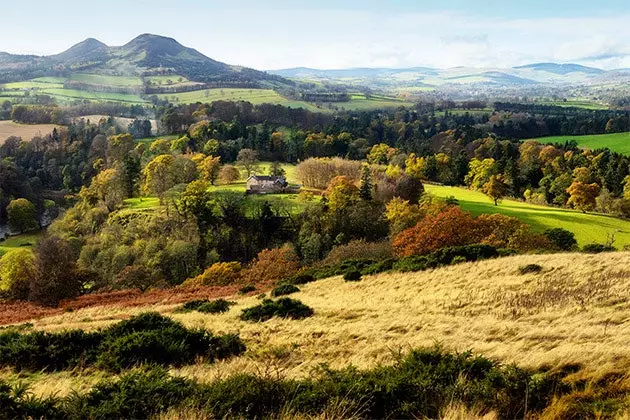
Panoramic view from Scott's View, the novelist's favorite
After spending the night in the exceptional The Roxburghe Hotel , breakfast based on Benedictine eggs and haggis, the famous Scottish sausage, predicted a good day . At the next table, Ben, a hunter who gathers energy with his gang before going out into the bush, prompts me with two proposals: "If you follow in Scott's footsteps you must go to Smailholm tower, but first stop by Kelso horse racing! ”. in the borders there are few rituals more sacrosanct and that allow to know the spirit of its inhabitants that one morning in one of its racecourses, where to verify its passionate relationship with horses.
"It is not weird. Here, since the 13th century we have been subject to looting and raiding from the north of England , so people had to get used to defending their possessions and lives with horseback riding,” explains Trish Spours, racetrack manager. That would justify the reason for the Common Ridings, horseback tours that the towns of the region do every summer . Diving into the human geography that populates the esplanade dotted with betting shop stalls. There is a motley torrent of bettors, curious, horse owners and types difficult to categorize. Scott would have lit up a good story with those wickers . Also, this is not Ascot and therefore Hats and hats to drink the cocktail or champagne do not mark the label ; here the king is tweed, the rough and resistant wool fabric born along the River Tweed, as mighty as the hectoliters of beer that hydrate the shouting in the Border dialect.
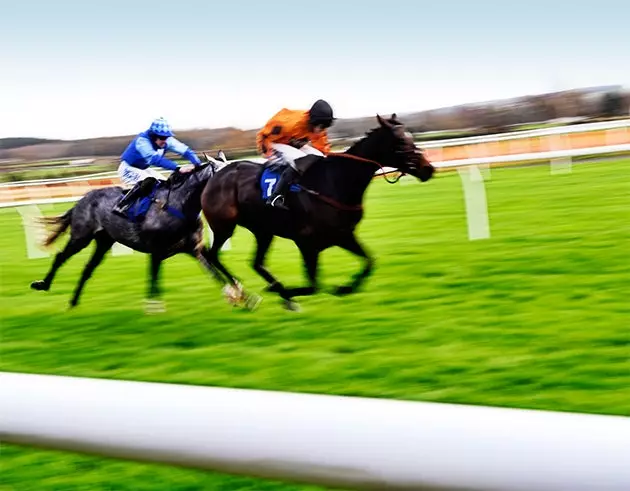
Kelso's 'relaxed' horse races
After a light lunch in the Floor Castle's Terrace Cafe I reread Pearson's biography. Rarely has a disease, in this case polio, been so decisive in a literary awakening . In 1773, after affecting his right leg and leaving him lame for life, Scott was sent to his grandfather's farm at Sandyknowe, next to the medieval tower of Smailholm . "There, every mountain had its fable, every valley its legend, every river its song," recalls Pearson, "and in years to come the lame boy who gazed in ecstasy from the crags would pay his debt to Sandyknowe by making Scotland a fictional country." . And there I was stepping on kilometer 0 of a genius with a brisk sun glinting off the moldy rocks of Smailholm. I can't resist meeting the current owner of the farm . “No, my family is not related to him at all,” Michel replies. I ask him about working on such a special farm, witness to relentless raids. “ Today gangs of thieves no longer arrive, but the rock-bottom prices of milk and the lack of aid from the EU continue with the tradition of this land ”, he spits out with phlegm made in Borders.
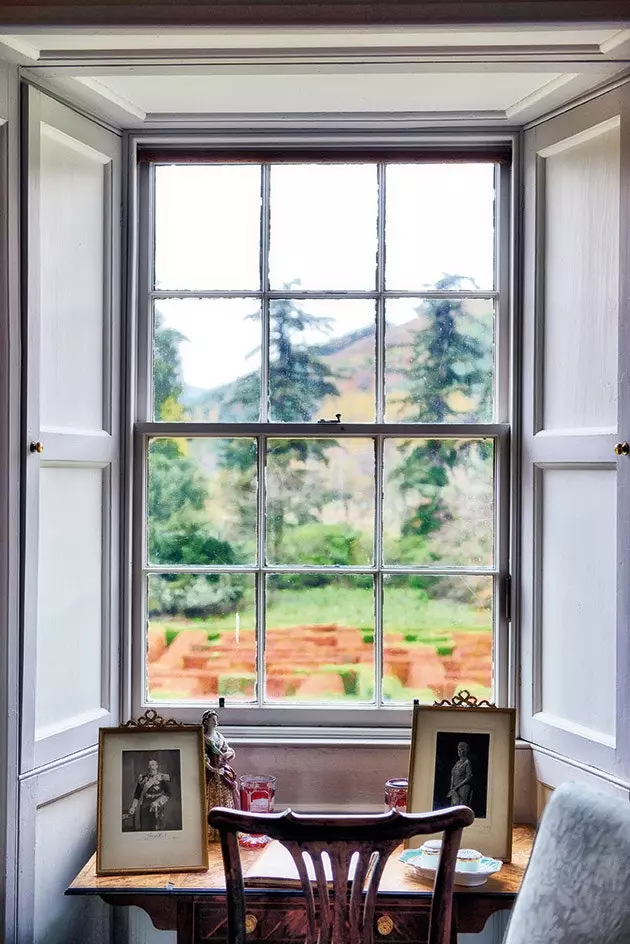
Traquair House, where Mary Stuart stayed
From Kelso the A23 runs between hills dotted with Border Cheviot sheep and woodland. It is the border of the border. Here the history of the Borders still beats strongly . Traquair House, a former royal hunting lodge and Catholic stronghold for 500 years, is in charge of remembering it. “ The history of Scotland and the Borders is written in these relics, on the walls of this house ”, affirms a warm female voice behind my back. She is petite, blonde, and with luminous blue eyes. "Good morning, I'm Catherine Maxwell Stuart," she introduces herself. She is not just any guide: she is the XXI Lady of Traquair, an aristocrat who, living with her family here she perpetuates it as the oldest inhabited manor house in Scotland.
Walking through her rooms is like stepping into a history lesson. When not a string of surprises. There are its doors and secret passageways to prove it, those that Scott, a close friend of its owner in the 19th century, Lady Louisa Stuart, knew perfectly well. “The house is the model of the mansion Tully Veolan in the novel Waverley and of the Shaw castle in The Waters of Saint Ronan”, confirms the aristocrat as she leads us to another room. “It served as a secret chapel from the end of the 17th century and as a home for the priest that the Stuarts of Traquair clandestinely they had lodged to serve the Catholic community ”, She remembers.
“What if someone ratted him out?” she asked. “ In the Borders you always had to have a plan B ”, she replies as she pushes the bookcase full of books. A secret staircase opens before our eyes. “If anti-Catholics came, I had time to escape,” she says with a smile. That afternoon, as she walked through the Japanese garden by the Stobo Hotel , an icy cold arrives together with some blackish clouds. I decide to plunge into the warmth of its spa , where I remember Lady Louisa's lesson: in the Borders you always have to have a backup plan.
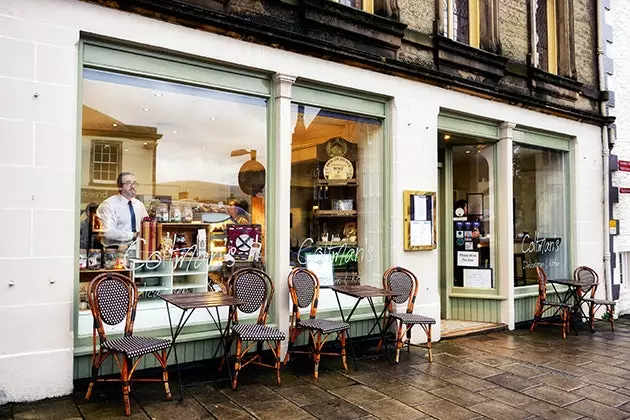
Cafe in Peebles
With a collection of Alasdair Fraser, the Mozart of the traditional Scottish fiddle , repeating in the car like a mantra, The Trossachs –The region whose poetic beauty inspired Scott like few others and which he turned into the first great literary and tourist destination in Europe– she appears without further ado. Trossachs means 'rough country' in Gaelic, which demonstrates its essence and justifies that, since 2002, much of the area was designated as Loch Lomond and The Trossachs National Park, the country's first national park.
Just like Scott did when his legal duties he was brought several summers to this part of “hard and wild Caledonia” –As he defined it–, I discover its beauty without ambiguity. Following the A84 road, Loch Lubnaig, the first link in the Scottish Scenic Routes , receives me in all its splendor. The top of Ben Ledi (879 meters), brown as the back of a bison, stands out against the sky. Making my way south, I enter the domain of the Cameron House , without a doubt, the best accommodation possible thanks to its restaurant and its golf course. Although from the window of my room I discover its true luxury: the Loch Lomond, Britain's largest freshwater loch , spreading between majestic mountains.
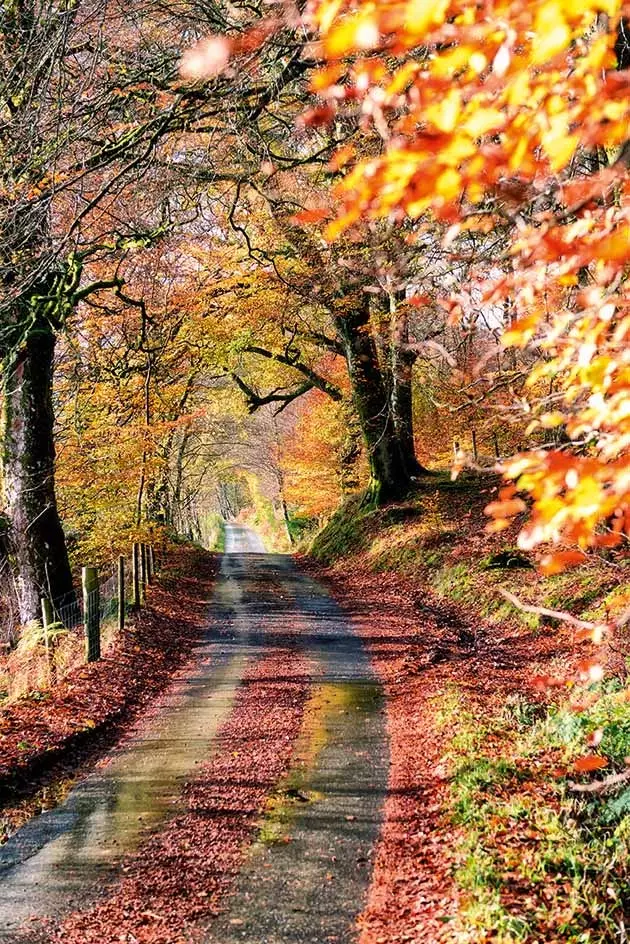
The path in Loch Lomond & The Trossachs National Park
The next morning, an unexpected cloudless sky turns the loch's waters into Scotland's best runway. “Discovering this part of the country from a bird's eye view on a day like this It is an experience that is not forgotten in life ”, affirms emphatically Eric Malan, of Loch Lomond Seaplanes, next to his yellow airplane. At ground level, alternatives are not lacking either: the Lomond is a paradise for both walkers who follow the West Highland Way as for pedal enthusiasts who travel the National Cycle Network Route 7. I decide to go by road to the city of Callander, on the banks of the Teith river.
Everything here is reminiscent of one of Scott's most famous literary creatures: Rob Roy MacGregor, the Scottish Robin Hood . From Callander the A81 winds its way around revealing Loch Venachar on the horizon. At the bottom of the valley, from Aberfoyle and after crossing the Duke's Pass, I reach the Loch Katrine . Few lochs in Scotland are so famous: here Rob Roy was born and began his escapades and it was here that Scott framed a poem, The Lady of the Lake , whose publication in 1810 broke all sales records for English poetry. With these works Scott enthroned Scotland in the mecca of tourism during the nineteenth century. Until today. At the pier, the boat Sir Walter Scott warms up as a long queue of passengers waits to take to the waters.
After knowing where the myth of Raibeart Ruadh was forged –his name in Gaelic–, it became inevitable, as Scott also did, to go to his final resting place to pay my respects . His grave is at Balquhidder, on the banks of Loch Voil. When I arrive, midday light makes a freshly cut white rose shine . Doze on the slab next to some coins. The red-haired Highlander would have laughed if he had been assured that, after his death, travelers would leave coins as they passed his grave. Me, just in case, I leave a few pounds as an offering.
Following the banks of Loch Doine, the little road ends at the gates of one of the gastronomic coordinates of the area: the Monachyle Mhor restaurant . A delicious brooch for the lands of Scott and Rob Roy, those that would still give me one last gift: the top of Beinn an t-Sidhean crowned by mist, the forest dressed in gold, green and red… A tribute for the pounds? Rob? Then I remember a quote from the book Écosse: Pierre, vent et lumière, by Nicolas Bouvier: “ I had been told and told that the landscapes of Scotland were among the most beautiful in the world, but they had not told me that it was the light , and not geology, which did all the work, unimaginable changing lighting that in one day creates more magical images than the eye can absorb. Whether it was a kind of suggestion or one of those Scottish mirages, for an instant I seemed to identify two familiar figures on the slope: the first, in a Ranger's kilt and a blue bonnet taming a russet hair, was ascending the slope like a deer. ; the other, limp but with a firm step, followed him along with a bull terrier. A second, a luminous wink, and the two figures were engulfed in a shroud of mist. This is Scotland, magical realism, a delightful fantasy novel.
* This article is published in the 82nd issue of the Condé Nast Traveler magazine for March. This number is available in its digital version for iPad in the iTunes AppStore, and in the digital version for PC, Mac, Smartphone and iPad in the Zinio virtual kiosk (on Smartphone devices: Android, PC/Mac, Win8, WebOS, Rims, iPad). Also, you can find us on Google Play Newsstand.
*** You may also be interested in...**
- Ecological Scotland: greener, impossible
- Touring Scotland from island to island
- Whisky: the amber soul of Scotland
- The 30 photos that make you want to travel to Scotland
- Scotland, ghost to ghost
- The 11 places you would never think are in Scotland
- Scotland, a journey of legend
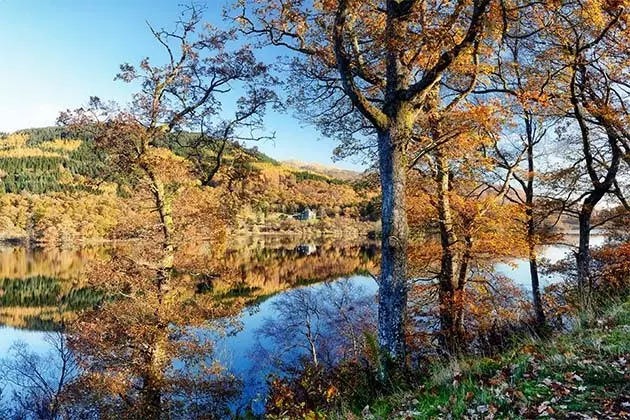
Loch Achray, a small freshwater loch north of Glasgow
